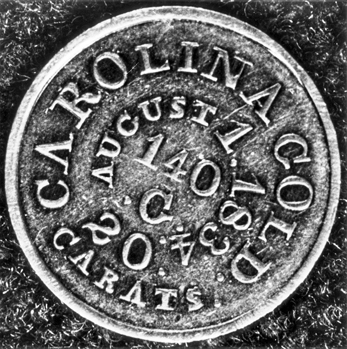Bechtler Mint
 Before gold was discovered in California in 1848, North Carolina was the leading gold-producing state. Although gold was found in some abundance in North Carolina, gold coins as a medium of exchange were not. Gold dust, nuggets, and jewelry often circulated as money since state and federal currency were scarce. The arrival in Rutherford County in 1830 of Christopher Bechtler, his son Augustus, and a nephew Christopher soon brought a change. They were experienced German metalworkers from the Grand Duchy of Baden who had gone to Pennsylvania in 1829. After a brief stay there they moved to North Carolina and settled near the center of a gold-producing area west of the Yadkin River that also included a small portion of northwestern South Carolina and northern Georgia.
Before gold was discovered in California in 1848, North Carolina was the leading gold-producing state. Although gold was found in some abundance in North Carolina, gold coins as a medium of exchange were not. Gold dust, nuggets, and jewelry often circulated as money since state and federal currency were scarce. The arrival in Rutherford County in 1830 of Christopher Bechtler, his son Augustus, and a nephew Christopher soon brought a change. They were experienced German metalworkers from the Grand Duchy of Baden who had gone to Pennsylvania in 1829. After a brief stay there they moved to North Carolina and settled near the center of a gold-producing area west of the Yadkin River that also included a small portion of northwestern South Carolina and northern Georgia.
Soon after opening a jewelry shop in Rutherfordton, the elder Bechtler realized that the regional economy was hindered by the lack of gold in circulation. Congress had rejected a petition for the establishment of a branch of the U.S. Mint in the area, so Bechtler, "at the suggestion of several gentlemen of highest standing" among the miners, decided to coin gold himself.
The Bechtlers manufactured their own dies and press and by July 1831 began striking coins in $2.50 and $5.00 pieces. For several weeks beginning on 2 July 1831, Christopher Bechtler advertised in the North Carolina Spectator and Western Advertiser in Rutherfordton that he had established a mint 3½ miles north of the town. In 1832 he began to produce $1.00 gold coins, the first gold dollar to be produced in the United States. The senior Bechtler died in 1842, and family members continued to produce gold coins until the late 1840s. In addition to coins, the Bechtlers were known for their collar buttons, cuff links, clocks, watches, watch chains, necklaces, brooches, rings, and firearms. They also operated a gold mine nearby but little is known about its production.
References:
Rodney Barfield and Keith Strawn, The Bechtlers and Their Coinage: North Carolina Mint Master of Pioneer Gold (1980).
Fletcher M. Green, "Gold Mining: A Forgotten Industry of Antebellum North Carolina," NCHR 14 (January 1937).
Additional Resources:
"Minting gold into coins." North Carolina in the New Nation. LearnNC.org. http://www.learnnc.org/lp/editions/nchist-newnation/4348
"Bechtler's Mint." North Carolina Highway Historical Marker Program. https://www.ncdcr.gov/about/history/division-historical-resources/nc-highway-historical-marker-program/Markers.aspx?ct=ddl&sp=search&k=Markers&sv=O-16 (accessed September 25, 2012).
Lattimore, Robin Spencer. Gold & glory: North Carolina gold and the Bechtler heritage. Rutherfordton, N.C.: Hilltop Publications. 2007.
Trinkley, Michael and Hacker, Debi. "An Archaeological Survey and Preservation Plan for the Bechtler Mint Site, 31RF157**." Columbia, S.C.: Chicora Foundation, Inc. 1995. http://www.chicora.org/pdfs/RC177%20-%20Bechtler%20Mint.pdf (accessed September 25, 2012).
PBS. "Gold Fever and the Bechtler Mint." http://www.pbs.org/video/2280029473/ (accessed May 5, 2016).
Image Credits:
Enlargement of the obverse of a five-dollar gold coin believed to have been struck between 1834 and 1837 by Christopher Bechtler Sr. The actual diameter of the coin is 24.7 mm. North Carolina Collection, University of North Carolina at Chapel Hill Library.
1 January 2006 | Holland, Ron